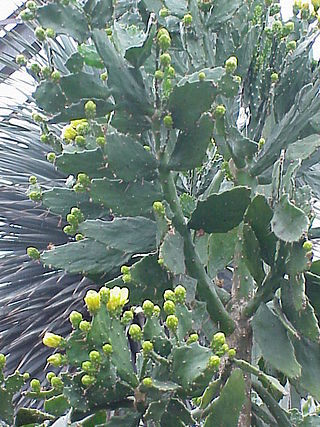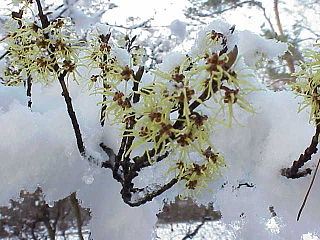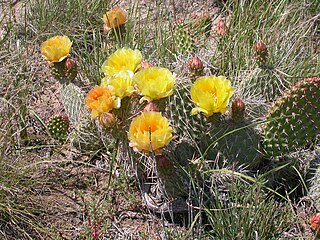
Cleistocactus strausii, the silver torch or wooly torch, is a perennial flowering plant in the family Cactaceae. It is native to mountainous regions of Department Tarija, Bolivia, at 1,500–3,000 m (4,921–9,843 ft).

Brasiliopuntia is a genus in the cactus family, Cactaceae. It contains only one species, Brasiliopuntia brasiliensis.

Opuntia engelmannii is a prickly pear common across the south-central and Southwestern United States and northern Mexico. It goes by a variety of common names, including desert prickly pear, discus prickly pear, Engelmann's prickly pear in the US, and nopal, abrojo, joconostle, and vela de coyote in Mexico.

Opuntia stricta is a species of large cactus that is endemic to the subtropical and tropical coastal areas of the Americas, especially around the Caribbean. Common names include erect prickly pear and nopal estricto (Spanish). The first description as Cactus strictus was published in 1803 by Adrian Hardy Haworth. In 1812 he moved the species to the genus Opuntia.

Opuntia phaeacantha is a species of prickly pear cactus known by the common names brown-spine prickly pear, tulip prickly pear, and desert prickly pear found across the southwestern United States, lower Great Plains, and northern Mexico. The plant forms dense but localized thickets. Several varieties of this particular species occur, and it may hybridize with other prickly pears, making identification sometimes tricky.

Hamamelis mollis, also known as Chinese witch hazel, is a species of flowering plant in the witch hazel family Hamamelidaceae, native to central and eastern China, in Anhui, Guangxi, Hubei, Hunan, Jiangxi, Sichuan, and Zhejiang.

Ferocactus viridescens is a species of flowering plant in the cactus family Cactaceae. This rare barrel cactus is known by several common names, including coast barrel cactus, keg cactus and San Diego barrel cactus. Most of its native range in the United States is in San Diego County, California, where it is threatened by development, agriculture, and other alterations in its habitat. It is also found in northern Baja California, Mexico.

Opuntia basilaris, the beavertail cactus or beavertail pricklypear, is a cactus species found in the southwest United States. It occurs mostly in the Mojave, Anza-Borrego, and Colorado Deserts, as well as in the Colorado Plateau and northwest Mexico. It is also found throughout the Grand Canyon and Colorado River region as well as into southern Utah and Nevada, and in the western Arizona regions along the Lower Colorado River Valley.

Opuntia humifusa, commonly known as the devil's-tongue, eastern prickly pear or Indian fig, is a cactus of the genus Opuntia present in parts of the eastern United States, Mississippi and northeastern Mexico.

Salvia fulgens, the Cardinal sage or Mexican scarlet sage, is a species of flowering plant native to the Mexican mountains adjacent to the state of Puebla, growing at 8,700-11,000 ft elevation. It prefers the edge of oak and coniferous woodlands, especially in clearings of Abies religiosa. The mountains receive fog and rain nearly year-round.

Mammillaria elongata, the gold lace cactus or ladyfinger cactus, is a species of flowering plant in the family Cactaceae, native to central Mexico. Growing to 15 cm (6 in) tall by 30 cm (12 in) wide, it consists of densely packed clusters of elongated oval stems, covered in harmless yellow or brown spines, and in spring producing white or yellow flowers. It is among the most common and most variable of its genus in nature, and is a popular subject for cultivation. It has gained the Royal Horticultural Society's Award of Garden Merit.

Opuntia, commonly called the prickly pear cactus, is a genus of flowering plants in the cactus family Cactaceae, many known for their flavorful fruit and showy flowers. Cacti are well-adapted to aridity, however, they are still vulnerable to alterations in precipitation and temperature driven by climate change. Prickly pear alone is more commonly used to refer exclusively to the fruit, but may also be used for the plant itself; in addition, other names given to the plant and its specific parts include tuna (fruit), sabra, sabbar, nopal from the Nahuatl word nōpalli, nostle (fruit) from the Nahuatl word nōchtli, and paddle cactus. The genus is named for the Ancient Greek city of Opus, where, according to Theophrastus, an edible plant grew and could be propagated by rooting its leaves. The most common culinary species is the "Barbary fig".

Opuntia aciculata, also called Chenille pricklypear, old man's whiskers, and cowboy's red whiskers, is a perennial dicot and an attractive ornamental cactus native to Texas. It belongs to the genus Opuntia. It is also widespread in Nuevo Leon and Tamaulipas.

Opuntia polyacantha is a common species of cactus known by the common names plains pricklypear, starvation pricklypear,. and hairspine cactus, panhandle pricklypear. It is native to North America, where it is widespread in Western Canada, the Great Plains, the central and Western United States, and Chihuahua in northern Mexico. In 2018, a disjunct population was discovered in the Thousand Islands region of Ontario, Canada.

Opuntia macrocentra, the long-spined purplish prickly pear or purple pricklypear, is a cactus found in the lower Southwestern United States and Northwestern Mexico. A member of the prickly pear genus, this species of Opuntia is most notable as one of a few cacti that produce a purple pigmentation in the stem. Other common names for this plant include black-spined pricklypear, long-spine prickly pear, purple pricklypear, and redeye prickly pear.

Mammillaria carmenae, the Isla Carmen pincushion cactus, is a species of flowering plant in the family Cactaceae.

Mammillaria plumosa, the feather cactus, is a species of flowering plant in the family Cactaceae, native to Northeastern Mexico.

Opuntia rufida is a species of prickly pear cactus native to southwestern Texas and northern Mexico, where it grows on rocky slopes. The species makes up for its total lack of spines with a profusion of red-brown glochids. The common name blind prickly pear or cow blinder comes from the fact that the glochids may be carried away by the wind and blind animals.

Mammillaria surculosa is a species of flowering plant in the cactus family Cactaceae, native to north eastern Mexico, where it occurs in extremely isolated patches at altitudes of 950–1,200 m (3,120–3,940 ft). It is registered as “Endangered” by the IUCN Red List. Growing to 10 cm (3.9 in) tall by 50 cm (20 in) wide, this tiny plant forms colonies of spiny stems with relatively large, lemon yellow flowers in spring.

Mammillaria sphaerica, the longmamma nipple cactus or pale mammillaria is a species of flowering plant in the cactus family Cactaceae, native to south eastern Texas in the USA and north eastern Mexico, where it occurs in scattered patches at altitudes up to 1,000 m (3,300 ft). It forms clumps of small pale green spheres to 5 cm (2.0 in) in diameter, with short hairs and pale yellow flowers up to 3 cm (1.2 in) wide in summer.
























